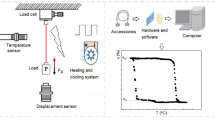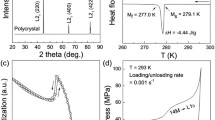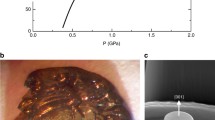Abstract
Shape-memory alloys suitable for low-temperature environments are crucially lacking despite their potential applications for aerospace engineering, superconducting technologies, and liquefied-gas-storage technologies. Even for benchmark shape-memory alloys such as Ti–Ni and Ni-based Heusler alloys, superelasticity becomes appreciably difficult to achieve upon cooling because of a drastic increase in stress hysteresis. Here, we report a superelastic strain of more than 7% for a Cu–Al–Mn shape-memory alloy down to 4.2 K with stress hysteresis as small as that at ambient temperature. Furthermore, the transformation entropy change remains as large as that at ambient temperature down to ~50 K. Consequently, an excellent elastocaloric cooling property is simultaneously obtained even at cryogenic temperatures, at which existing shape-memory alloys lose this property because of decreased entropy change and increased stress hysteresis. The developed cryogenic superelastic alloy shows excellent potential as a new class of material combining superelastic properties with sufficiently small dissipated energy and persistent elastocaloric cooling ability even in cryogenic environments.
Similar content being viewed by others
Introduction
Shape-memory alloys (SMAs) are alloys that undergo the diffusionless solid–solid phase transformation known as martensitic transformation (MT). Their functionalities—the shape-memory effect and superelasticity—have long stimulated considerable interest in the field of materials science and engineering. The superelasticity enables a large recoverable strain to be attained using the stress-induced forward/reverse MTs via the application/release of uniaxial stress.1 The behavior is similar to that of elastomers; the stress–strain (σ–ɛ) curve exhibits plateaus but not linearity as a superelastic response.1 This functionality has resulted in many important applications, such as guide wires and dam** components.1, 2, 3 In addition, refrigeration using the latent heat yielded by the stress-induced MT has recently received considerable attention as an environmentally friendly refrigeration technique called elastocaloric cooling (EC),4 which may be a promising alternative to conventional vapor-compression techniques. This EC effect (previously termed the piezocaloric effect5) exploits the transformation entropy change ΔS as a cooling source under adiabatic conditions. ΔS is related to the equilibrium stress σ0 and transformation strain ɛSE by the Clausius–Clapeyron equation:6

where Vm represents molar volume. Therefore, investigating the temperature dependence of superelastic behaviors can be used as an indirect approach to evaluate the EC potential of SMAs.
In the design of practical SMAs, minimizing the transformation hysteresis without deteriorating the shape-memory and/or superelastic property is a general strategy because it leads to reproducibility of these functionalities and enhancement of their fatigue properties.7 However, simultaneously achieving small σhys and large ɛSE (or ΔS) remains challenging. Even for the R-phase (trigonal-symmetric martensite) transformation in Ti–Ni, which exhibits a small temperature hysteresis of less than a few degrees Kelvin, the obtainable ɛSE is <1%;8 therefore, ΔS is also small. In contrast, σhys in SMAs with large ɛSE, for example, in FeNiCoAlTaB,9 is generally large. Recently, an extremely small temperature hysteresis and thereby excellent fatigue properties were achieved in certain SMAs10, 11, 12 because of the very small lattice mismatch between the parent and martensite phases10, 11 or among them and precipitates12 arising from special relationships intrinsic to their lattice correspondence10, 11, 12, 13 (termed ‘supercompatibility’ by James14). Another, more conventional approach involves tailoring the microstructure to reduce intergranular constraints; the fatigue properties of Cu–Al–Mn SMA in the forms of a single crystal, bamboo-like polycrystals, and columnar-oriented polycrystals have been successfully improved while realizing small σhys and large ɛSE.15, Ingots of Cu–17Al–15Mn and Cu–17Al–12Mn (at.%) were prepared by induction melting in an Ar atmosphere. The ingots were hot-rolled at 1143 K to reduce their thickness to ~3 mm. The obtained plates were subjected to cyclic heat treatment (see Supplementary Figure S1a) to obtain single crystals by inducing abnormal grain growth.26 The plates (shown in Supplementary Figure S1b) were subsequently annealed at 473 K for 15 min to stabilize the MT behavior between the cubic (L21) parent and monoclinic (18R, now often termed 6M) martensite phases.27, 28 As shown in Supplementary Figure S2, it was confirmed that the obtained Cu–17Al–15Mn does not undergo the thermally induced MTs in the temperature range 4–300 K. A series of tensile tests of Cu–17Al–15Mn single crystals was performed at a strain rate of 5 × 10−5 s−1 in order from the highest to lowest test temperatures. To account for the training effect, the tests were conducted at least twice at every temperature, and the σ–ɛ curve obtained in the final test was used. The tensile orientations in the tested single crystals were determined using the electron backscattered diffraction technique. The tensile σ–ɛ curves of the Cu–Al–Mn single-crystal specimen (#1) in the low-strain region at temperatures of 4.2–160 K are presented in Figure 2. The series of σ–ɛ curves indicates that the superelastic property was successfully achieved at all the temperatures tested. The two insets show the full superelastic curve at 4.2 K and the crystallographic orientation of the tested crystal on an inverse pole figure. Those for another crystal (#2) with a different orientation are provided in Supplementary Figure S3. The ɛSE values of 7.1% and 5.3% for specimens #1 and #2 at 4.2 K are less than the theoretical values of 9.1% and 7.6%, respectively, estimated from the crystallographic relationship between the cubic (L21) parent and monoclinic (18R) martensite phases in a Cu–17Al–10Mn SMA at ambient temperature.29 This discrepancy may have been caused by a change in the lattice parameters resulting from the different Mn concentration and temperature. The critical stresses, σMs and σAf, of the stress-induced forward/reverse MTs, as depicted in Figure 2, are plotted in Figure 3a as a function of temperature. Those reported for bamboo-textured30 and columnar-grained27 high machinability,27 improved fatigue life,16 grain size tunability,26 and transformation temperature tunability.28 It has been reported that the near <100>-oriented single crystal exhibits very large ɛSE approaching 10%.31 If we assume ɛSE=10%, σMs=50 MPa at 4.2 K, temperature-independent σhys=20 MPa, and critical slip stress=500 MPa in the near <100>-oriented single crystal, operations of superelasticity at temperatures up to 366 K and of the EC effect at temperatures as low as TCO=24 K may be feasible; one specimen can exhibit both superelasticity and the EC effect over a wide temperature window of ~340 K. As previously mentioned, the crystallographic compatibility between the parent and martensite phases10, 11, 12, 13 was considered to be a factor determining the magnitude of the MT temperature hysteresis. Although experimental investigations have not been attempted, this guidance appears to be valid for suppressing σhys and temperature hysteresis; thus, the existing COPmat metrics (Figure 5) may be revised for such supercompatible superelastic alloys. However, it is concerning that these conditions can be easily disrupted by changing temperature and composition. It remains unknown how thermal activation develops as temperature decreases because the extremely small hystereses are all observed at ambient temperatures at which the athermal nature is dominant. Therefore, the novel feature of the present Cu–Al–Mn alloy, namely, the temperature-independent small σhys and persistent EC performance over a very wide temperature range, will not be lost even after the supercompatible strategy is applied to design a superelastic alloy. As shown in Figure 6, the present Cu–Al–Mn alloy exclusively covers the application fields of space engineering, superconducting technologies, and liquefied-gas technologies, for which it has been almost impossible to implement existing SMAs. This material will contribute to innovative developments of these cryogenic technologies as well as the downsizing or simplification of various cryogenic systems.Materials and methods
Results and discussion
References
Otsuka, K. & Wayman, C. M. in Shape Memory Materials (eds Otsuka K. & Wayman C. M.) 149 (Cambridge Univ. Press, Cambridge 1998).
Jani, J. M., Leary, M., Subic, A. & Gibson, M. A. A review of shape memory alloy research, applications and opportunities. Mater. Des 56, 1078–1113 (2014).
Humbeeck, J. V. Non-medical applications of shape memory alloys. Mater. Sci. Eng. A 273–275, 134–148 (1999).
Bonnot, E., Romero, R., Mañosa, L., Vives, E. & Planes, A. Elastocaloric effect associated with the martensitic transition in shape-memory alloys. Phys. Rev. Lett. 100, 125901 (2008).
Nye, J. F. Physical Properties of Crystals, Oxford University: New York, (1957).
Wollants, P., De Bonte, M. & Roos, J. R. Thermodynamic analysis of the stress-induced martensitic-transformation in a single-crystal. Z. Metallk. 70, 113–117 (1979).
Suzuki, Y. & Tamura, H. in Engineering Aspects of Shape Memory Alloys (eds Duerig, T. W., Melton, K. N., Stockel, D. & Wayman, C. M.) (Butterworth-Heineman, London, 1990).
Stachowiak, G. B. & McCormick, P. G. Shape memory behaviour associated with the R and martensitic transformations in a NiTi alloy. Acta Metall. 36, 291–297 (1988).
Tanaka, Y., Himuro, Y., Kainuma, R., Sutou, Y., Omori, T. & Ishida, K. Ferrous polycrystalline shape-memory alloy showing huge superelasticity. Science 327, 1488–1490 (2010).
Zarnetta, R., Takahashi, R., Young, M. L., Savan, A., Furuya, Y., Thienhaus, S., Maaß, B., Rahim, M., Frenzel, J., Brunken, H., Chu, Y. S., Srivastava, V., James, R. D., Takeuchi, I., Eggeler, G. & Ludwig, L. Identification of quaternary shape memory alloys with near-zero thermal hysteresis and unprecedented functional stability. Adv. Funct. Mater. 20, 1917–1923 (2010).
Song, Y., Chen, X., Dabade, V., Shield, T. W. & James, R. D. Enhanced reversibility and unusual microstructure of a phase-transforming material. Nature 502, 85–88 (2013).
Chluba, C., Ge, W., de Miranda, R. L, Strobel, J., Kienle, L., Quandt, E. & Wuttig, M Ultralow-fatigue shape memory alloy films. Science 348, 1004–1007 (2015).
Cui, J., Chu, Y. S., Famodu, O. O., Furuya, Y., Hattrick-Simpers, J., James, R. D., Ludwig, A., Thienhaus, S., Wuttig, M., Zhang, Z. & Takeuchi, I. Combinatorial search of thermoelastic shape-memory alloys with extremely small hysteresis width. Nat. Mater. 5, 286–290 (2006).
James, R. D. Design of Supercompatible Shape Memory Alloys. Presented at the International Conference on Shape Memory and Superelastic Technologies (SMST 2017) (ASM International, San Diego, CA, 2017).
Sutou, Y., Omori, T., Yamauchi, K., Ono, N., Kainuma, R. & Ishida, K. Effect of grain size and texture on pseudoelasticity in Cu–Al–Mn–based shape memory wire. Acta Mater. 53, 4121–4133 (2005).
Liu, J., Huang, H. & **e, J. Superelastic anisotropy characteristics of columnar-grained Cu–Al–Mn shape memory alloys and its potential applications. Mater. Des. 85, 211–220 (2015).
Ma, J., Karaman, I. & Noebe, R. D. High temperature shape memory alloys. Int. Mater. Rev. 55, 257–315 (2013).
Nikolaev, V. I., Pul’nev, S. A., Malygin, G. A., Shpeizman, V. V. & Nikanorov, S. P. Pseudoelastic deformation and generation of reactive stresses in a Cu-Al-Ni shape-memory alloy in the temperature range 4.2–293 K. Phys. Sol. Stat. 49, 1878–1883 (2007).
Niitsu, K., Omori, T. & Kainuma, R. Stress-induced transformation behaviors at low temperatures in Ti-51.8Ni (at. %) shape memory alloy. Appl. Phys. Lett. 102, 231915 (2013).
Niitsu, K., Kimura, Y. & Kainuma, R. Transformation entropy change and precursor phenomena in Ni-rich Ti–Ni shape memory alloys. J. Mater. Res 32, 3822–3830 (2017).
Niitsu, K., Xu, X., Umetsu, R. Y. & Kainuma, R. Stress-induced transformations at low temperatures in a Ni45Co5Mn36In14 metamagnetic shape memory alloy. Appl. Phys. Lett. 103, 242406 (2013).
Forrest, J. A. & Dalnoki-Veress, K. The glass transition in thin polymer films. Adv. Colloid Interface Sci. 94, 167–196 (2001).
Yano, O. & Yamaoka, H. Cryogenic properties of polymers. Prog. Polym. Sci. 20, 585–613 (1995).
Fujii, H., Yamamoto, A., Yabumoto, M., Ogata, T., Hayashi, M., Saito, M., Okaguchi, S., Wada, Y. & Nakagawa, H. in Evaluation of Mechanical Properties of Austenitic Stainless Steels and Aluminium Alloy in Liquid Hydrogen. Hydrogen Energy Progress XII (Proc. of 12th World Hydrogen Energy Conference) (eds Bolcich, J. C. & Veziroglu, T. N.) 1893–1902 (Corradi Impressiones, Buenos Aires, Argentina, 1998).
Ogata, T., Ishikawa, K. & Nagai, K. Effects of strain rate on the tensile behavior of stainless steels, copper, and an aluminum alloy at cryogenic temperatures. Tetsu-to-Hagane 71, 1390–1397 (1985) (in Japanese).
Omori, T., Kusama, T., Kawata, S., Ohnuma, I., Sutou, Y., Araki, Y., Ishida, K. & Kainuma, R. Abnormal grain growth induced by cyclic heat treatment. Science 341, 1500–1502 (2013).
Kainuma, R., Takahashi, S. & Ishida, K. Thermoelastic martensite and shape memory effect in ductile Cu-Al-Mn alloys. Metall. Mater. Trans. A 27, 2187–2195 (1996).
Kainuma, R., Takahashi, S. & Ishida, K. Ductile shape memory alloys of the Cu-Al-Mn system. J. Phys. IV France A 05, 961–966 (1995).
Sutou, Y., Omori, T., Kainuma, R., Ono, N. & Ishida, K. Enhancement of superelasticity in Cu-Al-Mn-Ni shape-memory alloys by texture control. Metall. Mater. Trans. A 33, 2817–2824 (2002).
Niitsu, K., Omori, T. & Kainuma, R. Superelasticity at low temperatures in Cu-17Al-15Mn (at%) shape memory alloy. Mater. Trans. 52, 1713–1715 (2011).
Xu, S., Huang, H.-Y., **e, J., Takekawa, S., Xu, X., Omori, T. & Kainuma, R. Giant elastocaloric effect covering wide temperature range in columnar-grained Cu71.5Al17.5Mn11 shape memory alloy. APL Mater. 4, 106106 (2016).
Marcos, J., Planes, A., Mañosa, L., Labarta, A. & Hattink, B. J. Martensitic transition and magnetoresistance in a Cu-Al-Mn shape-memory alloy: influence of ageing. Phys. Rev. B 66, 054428 (2002).
Prado, M. O., Decorte, P. M. & Lovey, F. Martensitic transformation in Cu-Al-Mn alloys. Scr. Metall. Mater. 33, 877–883 (1995).
Omori, T., Ando, K., Okano, M., Xu, X., Tanaka, Y., Ohnuma, I., Kainuma, R. & Ishida, K. Superelastic effect in polycrystalline ferrous alloys. Science 333, 68–71 (2011).
Mañosa, L., Jarque-Farnos, S., Vives, E. & Planes, A. Large temperature span and giant refrigerant capacity in elastocaloric Cu-Zn-Al shape memory alloys. Appl. Phys. Lett. 103, 211904 (2013).
Brown, L. C. The thermal effect in pseudoelastic single crystals of β-CuZnSn. Metall. Trans. A 12, 1491–1494 (1981).
Rodriguez, C. & Brown, L. C. The thermal effect due to stress-induced martensite formation in B-CuAlNi single crystals. Metall. Mater. Trans. A 11, 147–150 (1980).
Lewandowski, J. J. & Greer, A. L. Temperature rise at shear bands in metallic glasses. Nat. Mater. 5, 15–18 (2006).
Qian, S., Nasuta, D., Rhoads, A., Wang, Y., Geng, Y., Hwang, Y., Radermacher, R. & Takeuchi, I. Not-in-kind cooling technologies: a quantitative comparison of refrigerants and system performance. Int. J. Refrigeration 62, 177–192 (2016).
Acknowledgements
This study was supported by JSPS KAKENHI Grant Numbers JP22226011 and JP12J07777.
Author contributions
R.K. supervised the study. K.N. and Y.K. performed the experiments. K.N. analyzed the data. K.N. and R.K. wrote the manuscript. T.O. contributed to the discussion of the results.
Author information
Authors and Affiliations
Corresponding author
Ethics declarations
Competing interests
The authors declare no conflict of interest.
Additional information
Publisher’s note
Springer Nature remains neutral with regard to jurisdictional claims in published maps and institutional affiliations.
Supplementary Information accompanies the paper on the NPG Asia Materials website
Supplementary information
Rights and permissions
This work is licensed under a Creative Commons Attribution 4.0 International License. The images or other third party material in this article are included in the article’s Creative Commons license, unless indicated otherwise in the credit line; if the material is not included under the Creative Commons license, users will need to obtain permission from the license holder to reproduce the material. To view a copy of this license, visit http://creativecommons.org/licenses/by/4.0/
About this article
Cite this article
Niitsu, K., Kimura, Y., Omori, T. et al. Cryogenic superelasticity with large elastocaloric effect. NPG Asia Mater 10, e457 (2018). https://doi.org/10.1038/am.2017.213
Received:
Revised:
Accepted:
Published:
Issue Date:
DOI: https://doi.org/10.1038/am.2017.213
- Springer Japan KK
This article is cited by
-
Exploding and wee** ceramics
Nature (2021)
-
Elastocaloric effect with small hysteresis in bamboo-grained Cu–Al–Mn microwires
Journal of Materials Science (2019)





